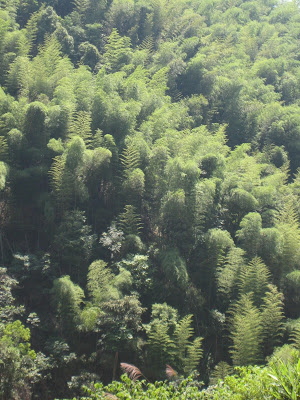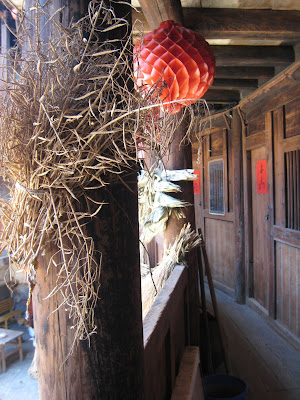This weekend we hired a driver to take us to the Hakka earth buildings. The road took us into the mountains, through bamboo hillsides, tea farms and rice terraces. From a distance this hill appeared to be covered with giant ferns. Upon closer inspection, they were a variety of bamboo.
 We caught a farmer out working his field with a water buffalo.
We caught a farmer out working his field with a water buffalo.
 The views were lovely and lacked most of the constant haze we have in Xiamen.
The views were lovely and lacked most of the constant haze we have in Xiamen.

The Hakka are an ethnic group geographically based in the mountains west of Xiamen, spanning several provinces. Their rammed earth buildings, called tulou, are unique architecturally. Our driver first took us to the tulou complex known as "four dish and one soup".
 As we approached the first tulou on foot, a man holding a baby was standing outside. We made conversation with him and he immediately invited us in for tea.
As we approached the first tulou on foot, a man holding a baby was standing outside. We made conversation with him and he immediately invited us in for tea.

 Together, we walked into their kitchen. His daughter joined us in conversation. They served tea in the tiniest cups I have ever used. They were even smaller than a child's tea set. Thankfully, these folks spoke Mandarin, because we would have been dead in the water, if we had to speak Hakka. We established that there were ten families living communally in this tulou. Each family had its own kitchen on the first floor. We had found an ancient form of co-housing that has stood the test of time!
Together, we walked into their kitchen. His daughter joined us in conversation. They served tea in the tiniest cups I have ever used. They were even smaller than a child's tea set. Thankfully, these folks spoke Mandarin, because we would have been dead in the water, if we had to speak Hakka. We established that there were ten families living communally in this tulou. Each family had its own kitchen on the first floor. We had found an ancient form of co-housing that has stood the test of time!
 An English-speaking visitor from Shanghai joined us for a quick cup of tea. After a brief exchange with our hosts, she explained to us that this tulou was built in the 14th century. WOW! These structures had withstood strong winds and earthquakes. My guidebook indicates that the juice of glutinous rice and some lime were mixed into the earth for strength, and that sliced bamboo, reeds, and sometimes pieces of wood were also used.
An English-speaking visitor from Shanghai joined us for a quick cup of tea. After a brief exchange with our hosts, she explained to us that this tulou was built in the 14th century. WOW! These structures had withstood strong winds and earthquakes. My guidebook indicates that the juice of glutinous rice and some lime were mixed into the earth for strength, and that sliced bamboo, reeds, and sometimes pieces of wood were also used.
 Due to the thick earthen walls, the kitchen where we were sitting was reasonably cool, even on this very hot day. They even invited us for a meal.
Due to the thick earthen walls, the kitchen where we were sitting was reasonably cool, even on this very hot day. They even invited us for a meal.
We climbed up to the second floor to check out the bedrooms. I could see that some of the construction was fired brick. The interior framing, pillars, and walls were made from sturdy-looking wood.

 Each room had a door and a window facing the interior courtyard. This provided natural lighting and some ventilation. The bedrooms were all locked. Everybody was hanging out downstairs. The next tulou we visited had more activity in their courtyard
Each room had a door and a window facing the interior courtyard. This provided natural lighting and some ventilation. The bedrooms were all locked. Everybody was hanging out downstairs. The next tulou we visited had more activity in their courtyard

 All of the tulous we visited had converted part of their ground level open areas to vendors selling souvenirs. The largest tulou we visited had a thriving market to take advantage of the busloads of tourists coming through.
All of the tulous we visited had converted part of their ground level open areas to vendors selling souvenirs. The largest tulou we visited had a thriving market to take advantage of the busloads of tourists coming through.
 All of the tulous we visited had one large, thick, wooden/metal door to get inside the structure. Most had no windows facing outside on the first couple of floors. They had a well somewhere in the open courtyard - complete with fish. This made for a defensible structure that had everything they needed to survive for short periods of time.
All of the tulous we visited had one large, thick, wooden/metal door to get inside the structure. Most had no windows facing outside on the first couple of floors. They had a well somewhere in the open courtyard - complete with fish. This made for a defensible structure that had everything they needed to survive for short periods of time.
 We had lunch at a picturesque river village inside a destroyed and partially renovated tulou. They were using their interior courtyard to dry medicine, beans, and laundry.
We had lunch at a picturesque river village inside a destroyed and partially renovated tulou. They were using their interior courtyard to dry medicine, beans, and laundry.
 Our lunch included one vegetable they grow locally that we could not identify. (Hint: it's not the green onions or the carrots)
Our lunch included one vegetable they grow locally that we could not identify. (Hint: it's not the green onions or the carrots)
 The village is home to a temple that honors the ancestors of the Zhang clan. A plaque explains how the stone dragon carvings used to be erected to honor their high ranking ancestors. Now they erect stone dragon carvings to honor overseas Chinese donors.
The village is home to a temple that honors the ancestors of the Zhang clan. A plaque explains how the stone dragon carvings used to be erected to honor their high ranking ancestors. Now they erect stone dragon carvings to honor overseas Chinese donors.

At this point, our wonderful journey disintegrated. At lunch, our driver indicated that he had never heard of the tulou I had originally asked him to drive us to. Instead he had brought us to the tulous pictured above. Then after lunch, he claimed there was a landslide between this village and all the tulous we had told him we wanted to visit. He refused to stop at the entrance/exit to ask about an alternate route. He refused to drive us on the proper road, claiming that all the roads led back to Xiamen, except for one very narrow motorcycle route, which was too narrow for a car. After the driver spent a slow hour not following the directions given by the local people, we realized that we really had no leverage to force him to drive anywhere. Our weekend trip to the Yongding tulous had turned into a long day trip to the Nanjing tulous.
Amazingly, when we asked local people for directions, if they were near their home, they would immediately invite us for tea. It truly is part of their culture, not just a show put on for the tourists visiting the tulous. Here are some more pictures to give you more of a flavor of our day.
















































No comments:
Post a Comment